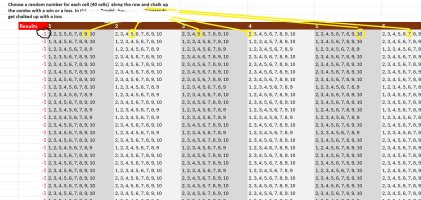I’ll explain all the details
Basically. On excel (please see image at end of post)
I have 40 cells going left to right
From bf9 to cs9. Or whatever but it’s 40 cells in a row.
Each cell will have 9 numbers between 1 to 10. They are all missing at least 1 number between 1 to 10
An example of a cell could be 1,2,4,5,6,7,8,9,10
Another could be 1,2,4,5,6,7,8,9,10
I have that going left to right for 40 cells.
On the left of these rows I then have a
2 or a -1
A 2 represents a win. A -1 represents a loss. Ive justed use those number but it doesnt matter what
I then have these 40 cells going down roughly 180,000 rows
What I want to do is find the best number combination with the best win rate
Best win rate being the wins to losses for each possible combination
So what is a number combination? A number combination is ONE number chosen from each of the 40 cells. (remember each cell contains 9 numbers seperated by commas)
I think I worked it out and there can be trillions of possibilities to mark each row
So if there is a 2 next to the first row with all those 40 cells of numbers. All the combinations in that row get chalked up with a win. Each row would have trillions of possibilities though because it’s 9 to the power of 40
And I basically need that done over and over again down 180,000 rows
And then I want the data of maybe the top 1000 combinations with the best win rates or something like that with at least a decent ammount of occurences
Is there a workaround this?

Basically. On excel (please see image at end of post)
I have 40 cells going left to right
From bf9 to cs9. Or whatever but it’s 40 cells in a row.
Each cell will have 9 numbers between 1 to 10. They are all missing at least 1 number between 1 to 10
An example of a cell could be 1,2,4,5,6,7,8,9,10
Another could be 1,2,4,5,6,7,8,9,10
I have that going left to right for 40 cells.
On the left of these rows I then have a
2 or a -1
A 2 represents a win. A -1 represents a loss. Ive justed use those number but it doesnt matter what
I then have these 40 cells going down roughly 180,000 rows
What I want to do is find the best number combination with the best win rate
Best win rate being the wins to losses for each possible combination
So what is a number combination? A number combination is ONE number chosen from each of the 40 cells. (remember each cell contains 9 numbers seperated by commas)
I think I worked it out and there can be trillions of possibilities to mark each row
So if there is a 2 next to the first row with all those 40 cells of numbers. All the combinations in that row get chalked up with a win. Each row would have trillions of possibilities though because it’s 9 to the power of 40
And I basically need that done over and over again down 180,000 rows
And then I want the data of maybe the top 1000 combinations with the best win rates or something like that with at least a decent ammount of occurences
Is there a workaround this?

